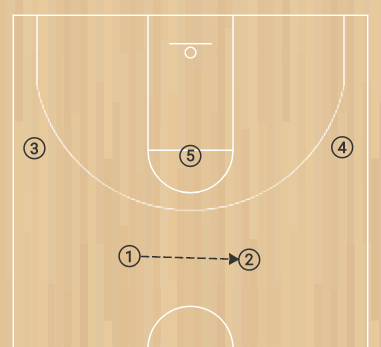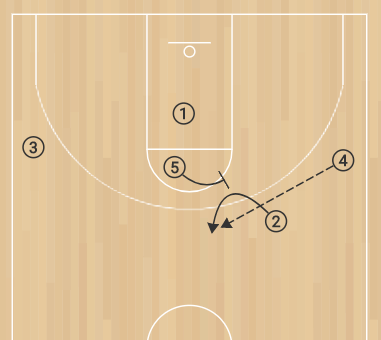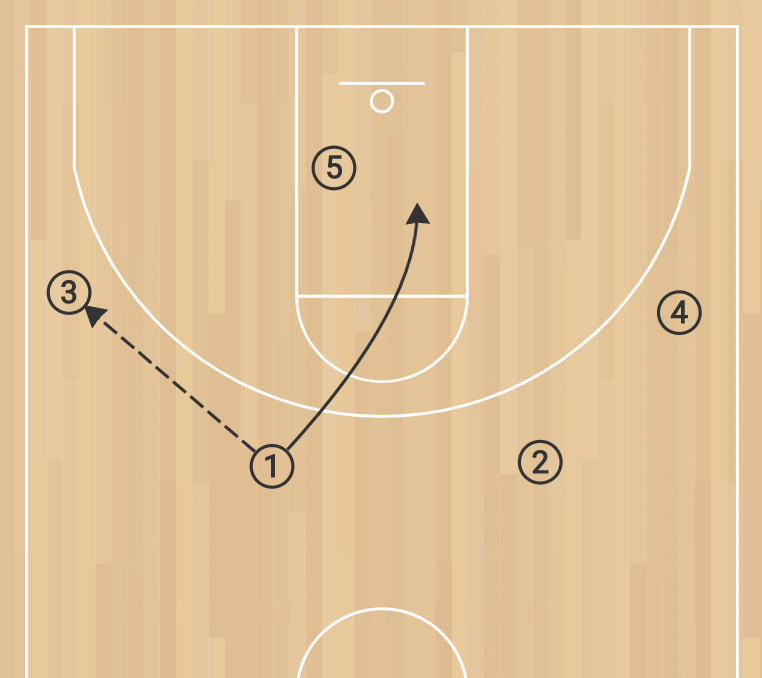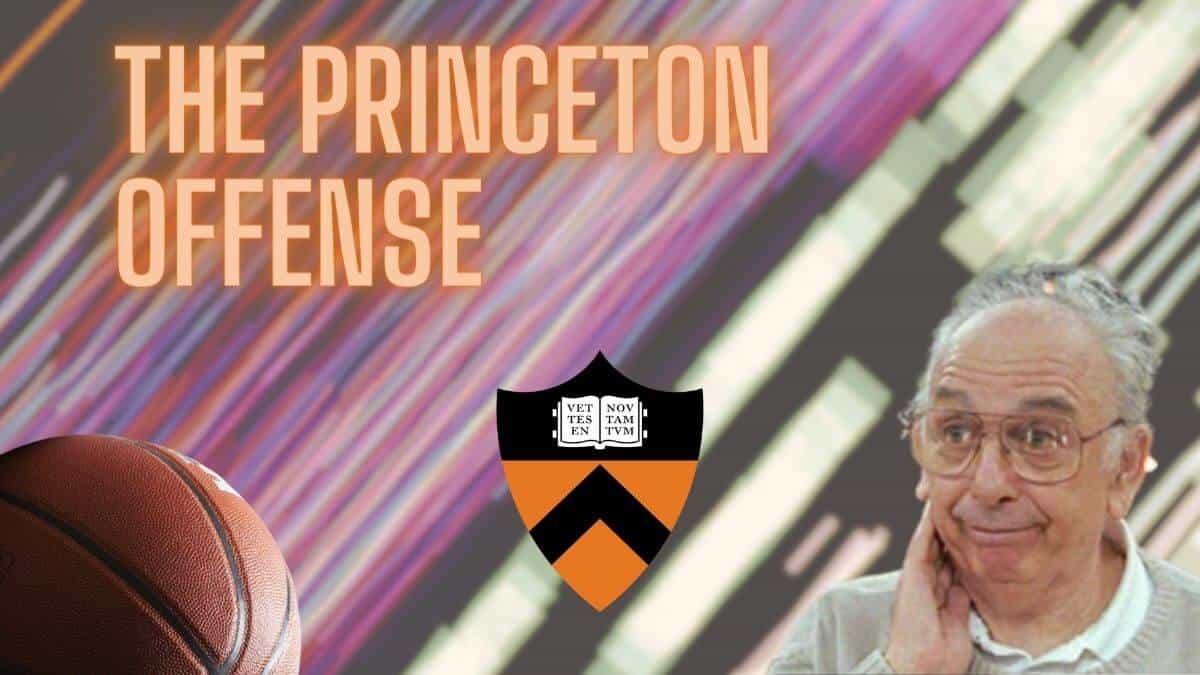The Princeton Offense is a basketball strategy refined by Pete Carril while coaching the Princeton Tigers in the 60’s. It’s often referred to as chin action basketball, as it leans heavily on the chin series of offensive movements.
It’s a fascinating and heady style of play that gets the entire team involved and working together. This is one of those systems that you could study for the rest of your life and never run out of options to explore.
You’ve got to be a little serious though, and have a fairly advanced team if you want to implement a Princeton offense. It can take some real effort to get it working. But if you can get that concentrated effort and the buy-in from your team, the rewards are there.
Our goal here is to help you build a basic understanding of the Princeton play set and leave you with some resources to continue the journey. We’ll cover the driving concepts of this classic offensive framework, how to think about implementing it, and how to consider a counter. But we’re also gonna dig into the history and theory behind the infamous Princeton Offense.
Here we go…
How does the Princeton offense work?
The Princeton offense uses constant movement to hunt out and generate gaps in a defense. A post player floats near the free-throw line. Four perimeter players are spaced around the arc. Systems of passing and screening are repeated until a gap is created for a backdoor cut or an open shot.
A simple concept, but the reality is quite complicated. It has been said that this is the most complex system of offense in basketball, and it can take years to understand it meaningfully.
Coaches and players can use the Princeton offense by teaching players the basic principles of spacing, motion, and passing, as well as providing drills and practice sessions to help players develop their skills. Variations of the offense can also be used to adapt to different opponents and defensive strategies.
How to Spot the Princeton Offense
The hallmark of a Princeton Offense is a big that hangs out at the line. You’re probably also gonna notice a lot of dribble handoffs at the wing and frequent backdoor cutting. But perhaps most obvious is the constant ball movement around the perimeter combined with players switching positions.
Player Roles in the Princeton Offense
A defining characteristic of the Princeton Offense is a lack of traditional position play. You basically just have a post player and a bunch of guards.
Your style of play then, is not really determined by any label or skill set, but more by your position on the court at any given moment. All of the perimeter players should understand how to operate the offense, execute the various sets, and move fluidly around the arc.
Guards
As your offense approaches you should have 2 players cruising down the middle of the court in tandem. One of them will have the ball. As the defense closes out, the ball handler typically passes to that opposite guard.
And so it begins…
If the ball handler takes a screen off the post, be aware of the follow-up flare screen.
Frequently, the strong side players switch places with a dribble handoff. If you spot this, you should definitely switch places with your wing as well, dropping screens along the way to open them up for cuts. Now you’ve effectively become a wing.
Wings
If the occasion arises, you may need to take a backdoor cut. But you’re more concerned with adding to the space on the floor. Draw your defenders out. The further you pull your matchup away from the basket, the more space you’ve got down there to rush in.
If a pass goes to your side, be prepared to receive a quick follow-up pass. It depends on what play you’re running, but working the ball around the perimeter is a key feature of this offense.
Post
The post player serves as a pivot, often receiving the ball from the perimeter players and making decisions about passing, shooting, or driving to the basket. They typically play very high on the court in this offense, near the top of the key. Hopefully you can drag the opposite big out there with you.
You’re running a lot of screens here. Understand how to anticipate and set screens for each of the sets, and roll smoothly off into the corresponding drift screen.
The Princeton Offense Play Set
The Princeton Offense incorporates a bunch of different play sets that can be run as needed. Carill mostly references three sets, a high set, a low set and the chin set. Each set has its own rules, but they’re all designed to create movement and confusion on the court, leading to scoring opportunities.
There’s a lot more to this offense. There’s very little that could be said to be outside of the realm of the Princeton offense, honestly. But here are the basic series involved here.
The Chin Series
The Chin Series starts with a screen at the high-post, a hallmark of the horns style offense. But the result is a little different.
You initiate the play with the standard Princeton formation. A big on the free-throw line and everyone else spaced around the perimeter. Your ball handler crosses the ball to the opposite side. Like this…

Internalize that diagram. It’s one of the keys to demystifying this offense. You approach the defense and you flip the ball to the opposite side.
Now let’s look at what’s commonly called the chin cut…
The Chin Cut
Player 1 accepts the chin screen. As the new ball handler gathers the attention from the defense, the previous ball handler sprints into a screen off of that post who’s hanging out at the stripe.

Now we have options. The classic action here is to immediately launch a follow-up pass to player 4 in the corner. If 1 is open, that’s a dead-simple layup. But what if 1 isn’t open?
This is where the flare screen (sometimes referred to as the drift screen) comes in.
The Flare Screen
After completing that initial chin screen, the post can drift over to set a follow-up screen for the opposite wing. The corner can then reverse the pass right back to the wing and open up a clean shot from the top of the arc. In this case, 2 accepts the screen, gets the ball right back from 4.

If the defender on 2 goes under the screen, they’re leaving 2 wide open with plenty of time for a shot. If the Defender tries to jump over the screen, 2 can curl straight in towards the basket.
Alternatively, 2 can always just pass off to the opposite side and just run another cycle of offense with player 1 taking one of the corner spots. One of the coolest things about the Princeton Offense is that it can be cyclical, running the various sets over and over until the defense leaves a gap.
The Chin Series can also transition smoothly into a 5-out offense, which provides more space for players to drive to the basket or shoot from outside.
The Point Series (a.k.a High Post)
While the chin series is probably the most iconic set of the Princeton Offense, the point series is likely the most common.
The post player will shift off to one of their corners for this, roughly 1 step out and up from the elbow. Often, they’re charging up from the low post. The play really initiates with a pass to that high-post. However, you’re usually going to start with the traditional guard to guard Princeton crossover first.
The point series now offers that guard that dropped the ball to the center three basic options.
Away
The guard breaks away from the center and sets a screen for the nearest player on the weak side. But in this case, that wing player will reverse and cut towards the basket. This is a bit of a hesitation move, where you’re trying to fake a screen out, but you sneak backdoor.
The screener is supposed to jump back off of the screen here to get open. That way, if the center can’t find an open lane to that cutter, they can hit the screener for a roll or a pop.
Under
Here the guard cuts through the paint and off to the strong side. There’s a lot more traffic here, but the guard can use that traffic to find space on the end of your trail. The extra wing on that side should help out with a pin down.
A good screen here, and the guard can swing back around for a dribble handoff from the center near the high post. This can result in a massive open look from deep if you do it right. Yet another option for the deep shooters in the Princeton Offense.
Over
The guard drives in, screening off of the center. The opposite player often uses that commotion as a screen to break to the opposite side of the court here.
The Low Post Series
If you’ve got a stronger post player, this becomes a little more attractive. As you might expect, this one starts off with your post deeper towards the basket.
The ball handler passes to the wing and cuts for the basket. That wing now has a lot of options. This motion is the basic entry for the low-post series.

If the cutter is open, you can feed them. But that low post is already down there as well, and should be the first passing look.
If the center accepts the pass, that wing can cut through the lane to the opposite corner while the center posts up. They can also cut to their own corner corner which may shift the defense favorably.
If the center is also well-guarded, you can charge the baseline and either drop the ball off to the center, or make an attempt yourself.
This video does a pretty good job of expanding on all of the options in this series.
Advantages and Disadvantages of the Princeton Offense
The Princeton Offense has some awesome advantages. It’s extremely adaptable to different personnel and situations. It spreads the floor and puts stress on a defense. It’s also an offense that relies heavily on teamwork and precision, which can build a lot of team confidence and cohesion.
However, the Princeton offense can be difficult to learn and execute, requiring a high level of basketball IQ and skill from all players on the court. It can also be vulnerable to pressure defenses that disrupt passing and cutting patterns.
Advantages
- Creates confusion and open shots.
- Demands interest and participation from the entire team.
- Leans on skill over athleticism.
- It doesn’t require a true big.
Disadvantages
- Very challenging to learn, understand and refine.
- You have to be pretty good at it as a team to pull it off well.
- Can be disrupted by press defenses that disrupt passing patterns.
Princeton Offense Drills
I’ve seen players work at this offense for years and still be mystified. It’s a tough one to work into.
Two of the core strategies you need to hone are screens and passing. Work at both until they’re second nature.
Simple Rotating Screen Drill
As simple as we can make it. Put a player at the high post. Organize your remaining players into two groups: defenders and rollers. Line them up parallel at the top of the arc. The first roller gets the ball.
On the whistle…
The roller advances towards the the high post. The defender closes out. The post player and the roller work together to set the screen. Roller passes to the next roller.
If the pass is successful, the defender takes the post spot and the post player heads to the back of the roller line. If the pass is incomplete, the defender and roller switch roles. The flow works out, I promise.
Shift this around by moving the post player or moving your lines to practice various angles of attack.
Basic 2-Man Passing Drill
Man or woman, or whatever, it doesn’t matter. Get two people. Get two balls. Pass back and forth.
Vary the passing styles: bounce pass, chest pass, weak hand pass, strong hand pass. Try mixing it up further with one hand doing a bounce pass and the other a high pass.
Then, pick up the pace.
5 out Passing Drill
Start in a 5-out setup, 5 players spaced around the perimeter. Run your offense without dribbling.
This works well if the passer cuts to the basket and the receiver immediately squares to the basket and then passes to the opposite side. Grind on this one for awhile for younger players.
The History of the Princeton Offense
So obviously we’ve already covered that this system originated with Pete Carril at Princeton. But let’s get a little deeper.
The Princeton Offense has been used successfully by college and professional teams for generations. Carill served for a time as Assistant Coach with the Sacramento Kings and you certainly still see his influence today. And of course the Princeton Tigers favor this style of offense to this day. But the numerous players and coaches who worked with Carril have spread this strategy far and wide. Even if a team doesn’t embrace the entirety of the set, you can spot elements of it in just about any offense.
Part of the reason the Princeton Offense has been so popular is that it can be very effective at spreading the floor. Even casual observers find it tough to miss that basketball has steadily evolved away from the paint. The success of the Princeton Offense certainly encouraged that, but more importantly, it serves a team that’s not afraid to take some long-range attempts.
Pete passed away in August of 2022. It’s pretty clear he was a funny character. Your typical candid basketball coach photo is going to display sternness and stoicism, often outright anger and frustration. Photos of Pete always seems to fall somewhere between whimsical and quizzical. That’s my kinda coach.
And his master set here goes right along with that. This thing is a whirlwind of confusion that just seems to work, so long as you have faith and keep at it. The Princeton set was one of the first offensive systems to really spread the floor, so it is closely tied to modern basketball. You could argue it paved the way.
Countering the Princeton Offense
Countering is often a factor of understanding how to disable the primary action in a set.
The Princeton offense is intricate, but there are certain patterns that are very common. You almost always see the dribble handoff on the wing, and backdoor drives to the basket.
The Hoopvision68 channel has a great breakdown on a college matchup where the Princeton was effectively disabled with by persistent on-ball defense. By interrupting some of the core structures of Richmond’s Princeton-style offense, the West Virginia Mountaineers were able to take a lot of the air out of the Spiders attacks.
Conclusion
This is a unique and effective basketball strategy that emphasizes teamwork and precision. The Princeton offense is based on principles of spacing and movement, screening and cutting.
While the Princeton Offense has several advantages, including its adaptability and reliance on teamwork, it can also be difficult to learn and execute. With practice and patience, however, it can be an effective strategy for any team.
